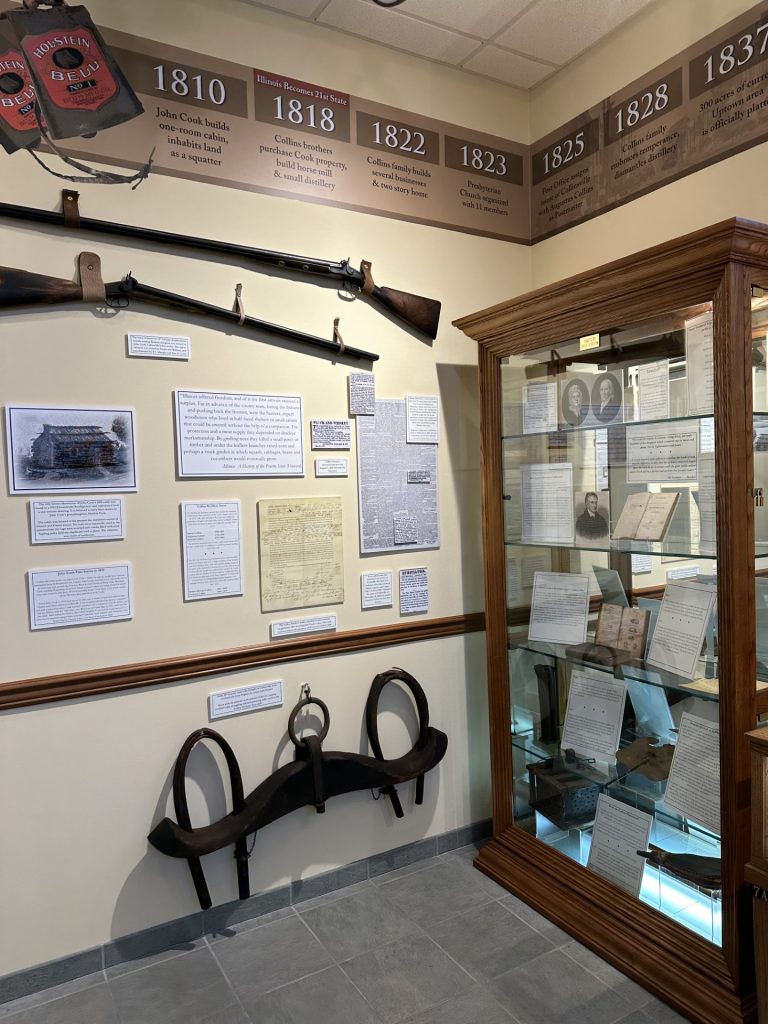Starting with a rather small exhibit, I decided to visit my local historical museum in the City of Collinsville, Illinois. The Collinsville Historical Museum is a squat and compact colonial building, often overshadowed by the much larger City Library standing almost in-front of the museum. Despite this, the interior of the museum displays an excellent use of space, featuring rows of diverse display cases that fill the room, adorn the the walls of the stairway, and carry-on into an additional display room on the lower level. Filling all of their limited space, but never feeling too cramped or cluttered, it is an expertly organized experience.
However, my goal is not to review the entire museum, but instead, a specific exhibit. Tucked into the left-most corner upon entry to the museum, in a small square box-like space, you will find yourself standing before the “Founders’ Room”, the newest exhibit display created by the Collinsville Historical Museum. The founders room represents a successful development in exhibit design for local museums, hopefully pushing other local communities to rethink how they can display their objects and form a strong narrative that engages visitors and gives them a more memorable experience.

The Founders’ Room serves as a visual story-teller, guiding visitors through the infancy of the City of Collinsville, and how it came to be what it is today. From its very beginnings in the early 19th Century throughout its development into the 20th century and beyond. Serving as quaint little window into the early colonial days of the Midwest, showing the local community a glimpse of the why and how Collinsville grew into the city it is today.

Upon entry to the exhibit space, visitors will be greeted with a slew of objects and information cards. Although the most immediate visual guide in the Founders’ Room is the timeline stretched along each wall of the room in a panoramic style. Starting from the left and wrapping across the entire room. Orienting visitors to view the room in a clockwise rotation. Creating a very easy to follow narrative fitting perfectly within the densely packed exhibit space.
The room itself is beautifully organized with a plethora of objects from the relevant period, featuring muskets, land deeds, portraits, and even clothes. Each wall features objects overlaid with images and interpretive labels, giving visitors a more complete story as their eyes scan down the wall from the reference date above. Recounting the details and first hand accounts of the events described on the timeline, mainly following the Collins family through their acquisition and development of the land that eventually became the city.
Within a matter of thirty minutes, a visitor can skim over each of the informational documents, within an hour and a half, a visitor could become an expert historian on the founding of Collinsville. I even found myself quite interested as I was circling the room (more than once) learning the history. Regardless of how much time a visitor chooses to spend on this exhibit, it always feels like there is something you may have glanced over too quickly, adding a great amount of depth to an otherwise tiny arrangement.

While the scale is rather small, the Founders’ Room manages to outshine the rest of the museums displays in one major sense; theme. The Founders’ Room offers a special consistency that is hard to find in most other local historical museums through a cohesive narrative. Especially in the local setting, considering how most local historical museums are limited by funds and the volume and/or quality of items donated by local residents. Leading to a generalized layout, where their only displays consist of WWII memorabilia, sports memorabilia, national news clippings, and the spare historical document found in a local’s attic.
I do not mean to disregard the value of those items, in fact, the Collinsville historical museum features them prominently in the main display spaces. But it goes without saying that local museums should strive to experiment with their design and not offer the same experience a visitor would find in a neighboring township. I believe that a proper investment into the inclusion of unique exhibit experiences could transform the public’s perspective, and in an industry where public perspective influences everything from funding to popularity, these developments will become more and more necessary.
The Founders’ Room serves as a small, but compelling step in the right direction for the growth of local historical museums. Branching into alternative methods of design, spatial awareness, and the use of thematic storytelling. Allowing the Collinsville Historical Museum to set itself apart from the much to consistent layout of local historical museums. I hope to see more experimentation like this in how other local historical museums address the design of their new and upcoming exhibits.
Leave a Reply